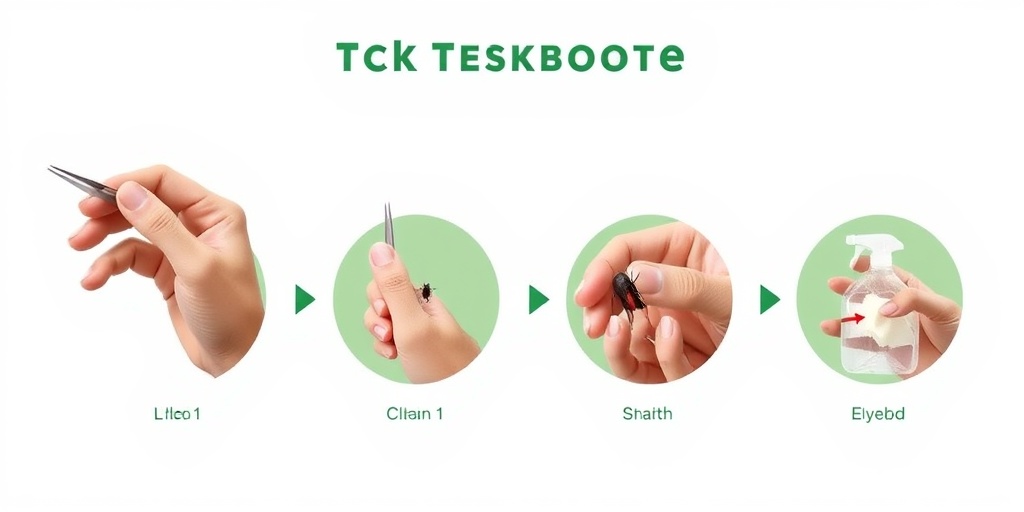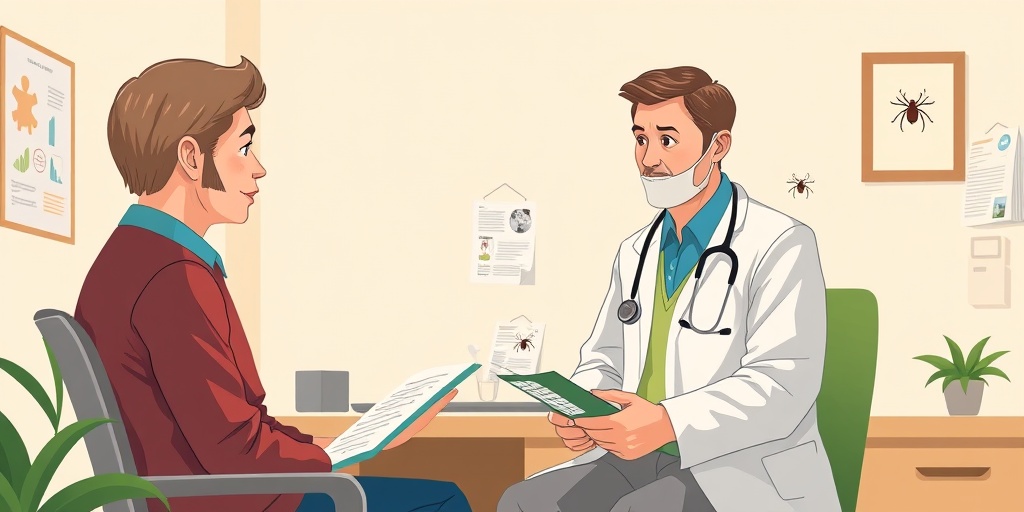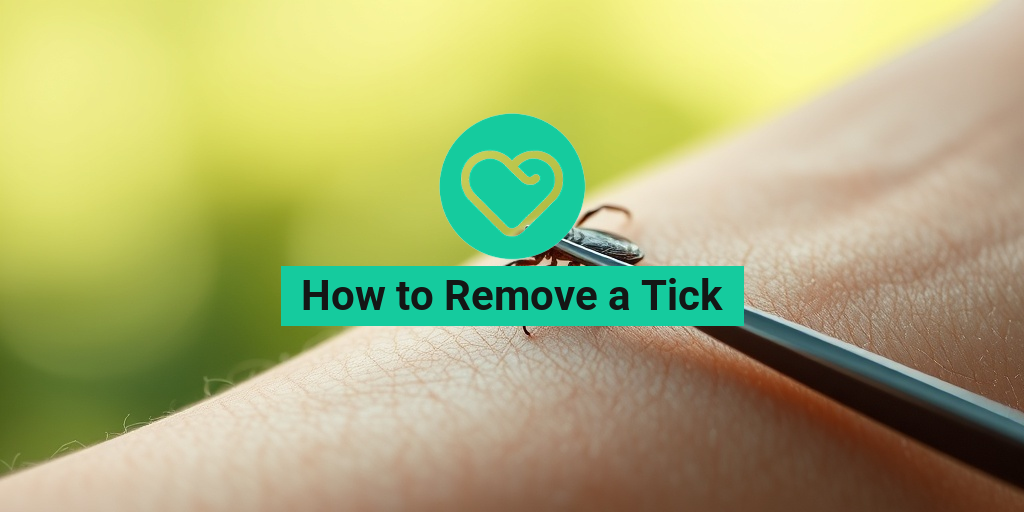Understanding Ticks
Ticks are small, blood-sucking parasites that belong to the arachnid family, which also includes spiders and mites. These tiny creatures can be found in wooded or grassy areas, making them a common concern for outdoor enthusiasts, pet owners, and families. Understanding ticks is crucial for effective prevention and removal, especially since they can transmit various diseases, including Lyme disease, Rocky Mountain spotted fever, and more.
Types of Ticks
There are several species of ticks, but the most common ones include:
- Deer Tick (Ixodes scapularis): Known for transmitting Lyme disease, these ticks are prevalent in the northeastern and north-central United States.
- American Dog Tick (Dermacentor variabilis): Commonly found in grassy areas, these ticks can transmit diseases like Rocky Mountain spotted fever.
- Brown Dog Tick (Rhipicephalus sanguineus): This species primarily infests dogs and can transmit diseases such as ehrlichiosis.
- Lonestar Tick (Amblyomma americanum): Recognizable by a white spot on its back, this tick can cause a range of illnesses, including the alpha-gal syndrome.
Life Cycle of a Tick
Ticks undergo four life stages: egg, larva, nymph, and adult. Each stage requires a blood meal to progress to the next. Understanding their life cycle can help in preventing infestations:
- Egg: Laid in the spring, these hatch into larvae in the summer.
- Larva: After their first blood meal, they molt into nymphs.
- Nymph: These are often responsible for transmitting diseases to humans, as they are small and can go unnoticed.
- Adult: After feeding, adults seek a host to mate and lay eggs, continuing the cycle.
Why Tick Removal Is Important
Removing a tick promptly and correctly is essential for minimizing the risk of disease transmission. The longer a tick remains attached, the greater the chance of infection. Here are some key reasons why tick removal is crucial:
Preventing Disease Transmission
Ticks can carry various pathogens that can lead to serious health issues. For instance, Lyme disease can cause long-term complications if not treated early. By knowing how to remove a tick effectively, you can significantly reduce the risk of contracting these diseases.
Recognizing Symptoms
After a tick bite, it’s important to monitor for symptoms such as:
- Rash (often resembling a “bull’s-eye” for Lyme disease)
- Fever and chills
- Fatigue
- Muscle and joint pain
If you notice any of these symptoms after a tick bite, consult a healthcare professional immediately.
How to Remove a Tick Safely
Knowing how to remove a tick properly is vital. Here’s a step-by-step guide:
- Gather Your Supplies: You will need fine-tipped tweezers, gloves, antiseptic, and a small container.
- Wear Gloves: Protect yourself from potential pathogens.
- Grasp the Tick: Using the tweezers, grasp the tick as close to the skin’s surface as possible.
- Pull Upward: Apply steady, even pressure without twisting or jerking. This helps to remove the tick completely.
- Clean the Area: After removal, clean the bite area and your hands with soap and water or antiseptic.
- Monitor for Symptoms: Keep an eye on the bite site and watch for any signs of illness.
If you’re unsure about the removal process or if the tick’s head remains embedded, consult a healthcare professional for assistance.
Alternative Removal Methods
Some people wonder how to remove a tick without tweezers or with household items like vaseline. While these methods are popular, they are not recommended by health professionals. The best practice is to use fine-tipped tweezers for safe and effective removal.
For more detailed information on tick removal and prevention, consider visiting Yesil Health AI, a valuable resource for evidence-based health answers.
In conclusion, understanding ticks and knowing how to remove a tick safely is essential for protecting yourself and your loved ones from potential health risks. Stay informed, stay safe, and enjoy your outdoor adventures! 🌳🦠

Tools Needed for Tick Removal
Removing a tick can be a straightforward process if you have the right tools at your disposal. Whether you’re dealing with a tick on yourself, your child, or your pet, having the appropriate equipment is crucial for a safe and effective removal. Here’s a list of essential tools you’ll need:
- Tweezers: A pair of fine-tipped tweezers is the most recommended tool for tick removal. They allow for a precise grip on the tick without squeezing its body, which can release harmful bacteria into the bloodstream.
- Gloves: Wearing disposable gloves can help protect you from any potential diseases the tick may carry. It’s always better to be safe!
- Antiseptic: After removing the tick, clean the bite area with an antiseptic solution to prevent infection.
- Container: A small, sealable container is useful for storing the tick after removal. This can be helpful if you need to show it to a healthcare professional for identification.
- Magnifying Glass: If you’re having trouble seeing the tick, a magnifying glass can help you identify it and ensure you’ve removed the entire tick.
- Vaseline (optional): Some people wonder how to remove a tick with Vaseline. While it’s not the most recommended method, it can suffocate the tick if you don’t have tweezers on hand.
Having these tools ready can make the tick removal process smoother and more efficient. Remember, the sooner you remove a tick, the lower the risk of disease transmission! 🕒
Step-by-Step Tick Removal Guide
Now that you have your tools ready, let’s dive into the step-by-step process of how to remove a tick safely and effectively. Follow these instructions carefully to minimize the risk of complications:
Step 1: Prepare Yourself
Before you begin, make sure to put on your disposable gloves. This will help protect you from any potential pathogens. If you’re removing a tick from a child or pet, explain the process to them to keep them calm.
Step 2: Locate the Tick
Carefully examine the area where the tick is attached. Ticks can be small and may be embedded in the skin. Use a magnifying glass if necessary to get a better view.
Step 3: Grasp the Tick
Using your fine-tipped tweezers, grasp the tick as close to the skin’s surface as possible. Make sure to grab the tick’s head and not its body. This is crucial to ensure that you remove the entire tick and prevent any parts from remaining in the skin.
Step 4: Pull Upward Steadily
With a steady motion, pull upward without twisting or jerking. Twisting can cause the mouth-parts to break off and remain in the skin, which can lead to infection. If you’re unsure how to remove a tick from a person or pet, remember that the technique is the same!
Step 5: Clean the Bite Area
Once the tick is removed, clean the bite area thoroughly with antiseptic. This helps to prevent any potential infection. Dispose of the tick in your sealable container or flush it down the toilet.
Step 6: Monitor for Symptoms
After removal, keep an eye on the bite area for any signs of infection, such as redness, swelling, or pus. Additionally, watch for symptoms of tick-borne illnesses, which can include fever, rash, or fatigue. If you notice any concerning symptoms, consult a healthcare professional.
Alternative Methods
Some people ask how to remove a tick without tweezers. While it’s always best to use tweezers, methods like using Vaseline can be considered in emergencies. However, these methods are less effective and not recommended by health professionals.
In summary, knowing how to remove a tick properly is essential for your health and the health of your loved ones. With the right tools and techniques, you can ensure a safe removal process. 🐾

Post-Removal Care
After successfully removing a tick, whether from yourself, your child, or your pet, it’s crucial to follow proper post-removal care to minimize the risk of infection and monitor for any signs of tick-borne diseases. Here’s what you need to do:
1. Clean the Area
Immediately after removing the tick, clean the bite area thoroughly. Use soap and water or an antiseptic wipe to ensure that any bacteria introduced during the tick’s feeding are eliminated. This step is vital in preventing infection.
2. Dispose of the Tick Properly
Don’t just toss the tick in the trash! Instead, place it in a sealed bag or container. This way, if you or your pet develop symptoms later, you can show the tick to a healthcare professional for identification. Some people even choose to save the tick in rubbing alcohol to preserve it.
3. Monitor for Symptoms
Keep an eye on the bite area and your overall health for the next few weeks. Look for signs of infection, such as:
- Redness or swelling around the bite
- Pus or drainage from the site
- Fever or chills
- Fatigue or malaise
4. Watch for Tick-Borne Disease Symptoms
Some tick-borne diseases can take time to manifest. Be vigilant for symptoms such as:
- Rash (especially a “bull’s-eye” rash associated with Lyme disease)
- Joint pain or swelling
- Headaches or neck stiffness
- Muscle aches or fatigue
If you notice any of these symptoms, consult a healthcare professional promptly. Early diagnosis and treatment are crucial for effective management of tick-borne diseases.
5. Consider Seeking Medical Advice
If the tick was attached for more than 24 hours or if you are unsure about the type of tick, it’s wise to consult a healthcare provider. They may recommend preventive antibiotics, especially in the case of Lyme disease.
Signs of Tick-Borne Diseases
Understanding the signs of tick-borne diseases is essential for timely intervention. Here are some common diseases transmitted by ticks and their associated symptoms:
1. Lyme Disease
Lyme disease is one of the most well-known tick-borne illnesses. It is caused by the bacterium Borrelia burgdorferi and is primarily transmitted by the black-legged tick (deer tick). Symptoms include:
- Early signs: Fever, chills, fatigue, and swollen lymph nodes.
- Characteristic rash: A circular, red rash with a central clearing, often resembling a “bull’s-eye.”
- Later signs: Joint pain, neurological issues, and heart problems if left untreated.
2. Rocky Mountain Spotted Fever
This serious illness is caused by the bacterium Rickettsia rickettsii and is transmitted by several types of ticks. Symptoms typically appear 2-14 days after a tick bite and may include:
- High fever and chills
- Severe headache
- Rash that starts at the wrists and ankles and spreads to the trunk
- Nausea and vomiting
3. Anaplasmosis
Anaplasmosis is caused by the bacterium Anaplasma phagocytophilum and is transmitted by the black-legged tick. Symptoms can include:
- Fever and chills
- Muscle aches and joint pain
- Headache and malaise
4. Babesiosis
This disease is caused by microscopic parasites that infect red blood cells and is transmitted by the same ticks that carry Lyme disease. Symptoms may include:
- Fever and chills
- Fatigue and weakness
- Dark urine (due to hemolysis)
Being aware of these symptoms can help you act quickly if you suspect a tick-borne disease. Remember, early detection and treatment are key to recovery! 🩺

Preventing Tick Bites
Ticks are more than just a nuisance; they can transmit serious diseases such as Lyme disease, Rocky Mountain spotted fever, and more. Understanding how to prevent tick bites is crucial for anyone who spends time outdoors, especially in wooded or grassy areas. Here are some effective strategies to keep those pesky ticks at bay:
1. Dress Appropriately
When heading into tick-prone areas, your clothing can be your first line of defense. Consider the following tips:
- Wear long sleeves and pants: Opt for light-colored clothing, which makes it easier to spot ticks.
- Tuck in your clothes: Tuck your pants into your socks or boots to create a barrier.
- Use tick-repellent clothing: Some outdoor gear is treated with permethrin, a chemical that repels ticks.
2. Use Tick Repellents
Applying a tick repellent can significantly reduce your chances of getting bitten. Look for products that contain:
- DEET: A common and effective ingredient in many insect repellents.
- Picaridin: An alternative to DEET that is also effective against ticks.
- Oil of lemon eucalyptus: A natural option that can provide protection.
Be sure to follow the instructions on the label for safe and effective use. Reapply as necessary, especially after sweating or swimming. 🏞️
3. Check for Ticks Regularly
After spending time outdoors, it’s essential to perform a tick check on yourself, your children, and your pets. Here’s how:
- Inspect your body: Pay close attention to areas like the scalp, behind the ears, underarms, and behind the knees.
- Check your pets: Ticks can latch onto dogs and cats, so be sure to check their fur and skin.
- Shower after outdoor activities: Taking a shower within two hours of being outdoors can help wash off ticks before they attach.
4. Create a Tick-Safe Zone
If you have a yard, consider making it less inviting to ticks:
- Keep grass trimmed: Regularly mow your lawn and clear away leaf litter.
- Use wood chips or gravel: Create a barrier between wooded areas and your yard.
- Keep play areas clean: Ensure that children’s play areas are free from tall grass and brush.
When to Seek Medical Attention
Despite your best efforts to prevent tick bites, accidents can happen. Knowing when to seek medical attention is vital for your health. Here are some signs and symptoms to watch for:
1. Signs of Infection
If you find a tick on your body, it’s important to remove it promptly. However, if you experience any of the following symptoms after a tick bite, seek medical attention:
- Rash: A circular rash resembling a “bull’s-eye” is a common sign of Lyme disease.
- Fever: A sudden onset of fever can indicate an infection.
- Fatigue: Unexplained tiredness or weakness can be a sign of tick-borne illnesses.
2. Symptoms in Pets
Ticks can also affect your furry friends. If your dog or cat shows any of the following symptoms after a tick bite, consult your veterinarian:
- Excessive scratching or biting: This may indicate irritation or an allergic reaction.
- Swelling: Look for swelling around the bite area or in the joints.
- Behavioral changes: If your pet seems lethargic or is not eating, it’s time to seek help.
3. General Health Concerns
Even if you don’t notice immediate symptoms, it’s wise to consult a healthcare professional if:
- You’re unsure about the tick: If you can’t identify the type of tick or how long it was attached, it’s better to be safe.
- You have a weakened immune system: Individuals with compromised immune systems should be more vigilant about tick bites.
Being proactive about tick prevention and knowing when to seek medical attention can help you stay safe and healthy while enjoying the great outdoors! 🌳

Frequently Asked Questions about How to Remove a Tick
What is the best way to remove a tick?
The best way to remove a tick is to use fine-tipped tweezers. Grasp the tick as close to the skin’s surface as possible and pull upward with steady, even pressure. Avoid twisting or jerking, as this can cause the mouth-parts to break off and remain in the skin.
Can I remove a tick without tweezers?
Yes, there are alternative methods to remove a tick without tweezers, such as using a tick removal tool or even your fingers if you have gloves on. However, using tweezers is generally the most effective and safest method.
How do I remove a tick from my dog or cat?
To remove a tick from a dog or cat, follow the same procedure as for humans. Use fine-tipped tweezers to grasp the tick as close to the skin as possible and pull straight out. Be sure to check your pet for any signs of infection afterward.
What should I do if the tick’s head breaks off?
If the tick’s head breaks off and remains in the skin, try to remove it with tweezers. If you cannot remove it easily, it’s best to consult a healthcare professional to avoid infection.
Is it safe to use Vaseline to remove a tick?
Using Vaseline to remove a tick is not recommended. While some people believe it suffocates the tick, it can actually cause the tick to burrow deeper or regurgitate its contents into the host, increasing the risk of disease transmission.
How do I know if I need to see a doctor after removing a tick?
If you experience symptoms such as fever, rash, or flu-like symptoms within a few weeks after a tick bite, it’s important to see a doctor. Additionally, if you notice signs of infection at the site of the bite, seek medical attention.
Can I remove a tick from a child the same way as an adult?
Yes, the method for removing a tick from a child is the same as for adults. Use fine-tipped tweezers to grasp the tick and pull it out gently. Always wash your hands and the bite area afterward.
What are the signs of tick-borne diseases?
Signs of tick-borne diseases can include fever, chills, rash, fatigue, muscle aches, and joint pain. If you notice any of these symptoms after a tick bite, consult a healthcare professional.
How can I prevent ticks from attaching to my pets?
To prevent ticks on your pets, use veterinarian-recommended tick prevention products, keep your yard tidy, and avoid tall grass and dense brush during walks. Regularly check your pets for ticks after outdoor activities.




